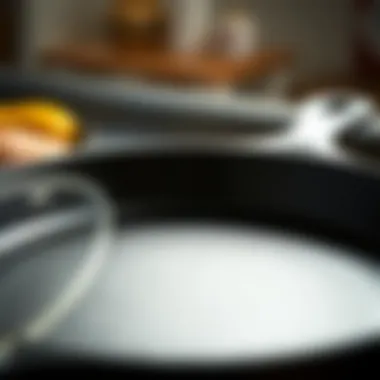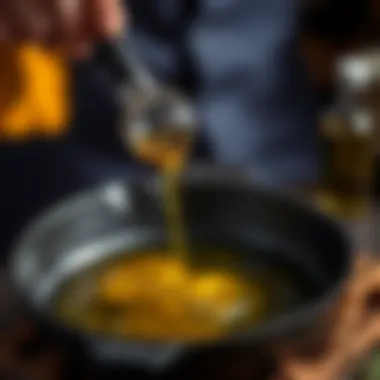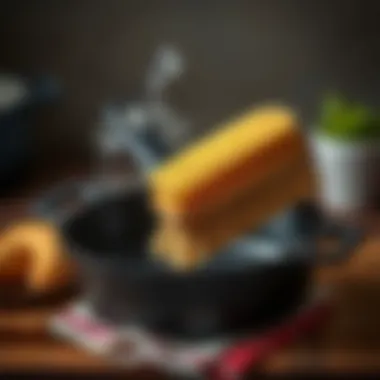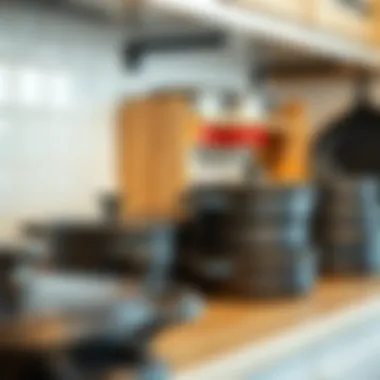Cleaning and Curing Cast Iron Cookware Guide


Intro
Cast iron cookware has been a staple in kitchens around the world for generations, prized for its durability, heat retention, and versatility. However, to truly harness the potential of these cast iron beauties, it’s essential to understand the art of cleaning and curing them. Many kitchen novices may wonder why it is necessary to devote time and effort to maintain these items, particularly when modern cookware options exist. The truth is, a well-cared-for cast iron piece can significantly enhance the cooking experience, providing a non-stick surface that improves with age.
Moreover, neglecting proper care can lead to a rusty, sticky mess that not only hinders performance but tarnishes the cookware’s reputation. This guide seeks to demystify the process of cleaning and curing cast iron, offering practical strategies tailored to fit a busy lifestyle.
Whether you’re whipping up a quick breakfast or simmering a hearty stew, understanding the upkeep of your cast iron is key. In this detailed narrative, we’ll dive into steps for effective cleaning, illuminate the significance of seasoning, and share time-saving tricks. So grab your favorite cast iron skillet and let’s get started on keeping it in top-notch shape!
Understanding Cast Iron Cookware
Cast iron cookware has been making its mark in kitchens for centuries, showcasing durability and versatility that few materials can rival. Understanding the nuances of cast iron is essential for anyone keen on maximizing the potential of their cooking equipment. This section explores pivotal elements, from the historical roots of cast iron to the different types available, ensuring your journey into the world of cast iron is well-informed and enriching.
History and Evolution of Cast Iron
Cast iron's past is as sturdy as the material itself. Originating in China during the Han dynasty, roughly around the 5th century BC, cast iron began as a method for creating tools and weapons. However, it didn't take long for the culinary world to recognize its potential. By the Middle Ages, cast iron cookware started appearing in European kitchens, specifically in the form of pots, pans, and dutch ovens.
The evolution of cast iron cookware continued into the 19th century, with innovations such as the introduction of enameling, making maintenance much easier while adding style. As generations passed, cast iron became a staple in American households, reflecting a deep-rooted culinary tradition often passed down through families. Today, manufacturers continue to innovate, providing cast iron options that express modern aesthetics while retaining traditional functionality.
Types of Cast Iron Cookware
Diving into the types of cast iron cookware helps in making informed choices for your kitchen needs. Here’s a breakdown:
- Skillets: Often seen as the workhorse of any kitchen. Available in various sizes, they can tackle everything from pancakes to steak.
- Dutch Ovens: These heavy, lidded pots are ideal for slow-cooking, braising, and baking. Perfect for stews or even artisan bread!
- Griddles: Flat cooking surfaces that allow for even heat distribution. Great for making multiple pancakes or sandwiches at once.
- Woks: Combine the benefits of cast iron with Asian cuisine, suitable for high-heat cooking techniques.
- Baking Pans: Cast iron can also shine in baking, with pans designed specifically for cornbread, pizza, and even cake.
Each type comes with its unique set of advantages, making them appropriate for various cooking styles.
Benefits of Using Cast Iron
The perks of incorporating cast iron into your cooking arsenal are manifold. Here’s why you should consider it:
- Heat Retention: Cast iron holds heat exceptionally well, providing even cooking and browning.
- Versatility: Use it on the stovetop, in the oven, or even over an open flame.
- Naturally Non-Stick: With the right seasoning, cast iron develops a natural non-stick surface over time, enhancing the flavor of dishes.
- Durability: A well-cared-for cast iron pan can last a lifetime, potentially even passed down to future generations.
- Nutritional Benefits: Minimal leaching of iron into food can contribute beneficial iron to your diet.
Using cast iron cookware embodies a blend of tradition and practicality, illustrating its relevance in both contemporary and classic culinary practices. As we delve deeper into the realms of cleaning and curing, appreciate what makes this material unique and essential for any culinary enthusiast.
Remember, the key to unlocking the full potential of your cast iron cookware lies in understanding it, keeping it clean, and maintaining its seasoning.
The Importance of Cleaning Cast Iron
Cleaning cast iron is not just about aesthetics; it’s a vital routine that ensures the longevity and durability of your prized cookware. These heavy-duty pieces require special attention due to their unique material properties. Regular care can prevent issues that compromise performance, making cleaning a critical aspect of maintaining cast iron.
Preventing Rust and Corrosion
One of the most significant threats to cast iron cookware is rust. Left unattended, moisture can creep in, leading to corrosion. This not only diminishes the visual appeal but also alters the cooking efficiency over time.
- Cast iron is porous, which means it can absorb liquids, making it particularly vulnerable to rust if not dried properly after cleaning.
- Steam and water left on the surface create a perfect storm for oxidation. To mitigate this, one should always dry cast iron thoroughly after washing—preferably while it’s still warm.
A practical approach to preventing rust is to develop a habit of seasoning your cast iron after every clean. This layer of oil acts as a protective barrier against moisture and contributes to the cookware's non-stick qualities. Remember, a well-seasoned pan is less likely to fall prey to the dreaded rusty exterior.
"An ounce of prevention is worth a pound of cure."
This adage rings especially true when it comes to cast iron. By prioritizing its cleanliness and maintenance, you are not only saving your cookware but also preserving the unique cooking characteristics that make cast iron beloved by culinary enthusiasts.
Maintaining Flavor and Quality


The flavors embedded in cast iron cookware are what set it apart from other materials. Over time, however, residues from cooking can accumulate and affect the taste of your dishes. This dual effect, where old flavors cling to the pan and fresh ingredients struggle to assert themselves, can lead to unpleasant surprises.
- Cleaning cast iron not only removes manufacturing residues but also the remnants of previous meals that can impart unwanted flavors.
- Skipping proper cleaning can result in a buildup of carbonized bits, leading to an acrid taste that can ruin your culinary creations.
To keep your cookware in top shape, make cleaning a ritual done after every use. The effort will pay off when you notice how the flavors of your dishes pop without lingering traces of past meals. A clean cast iron skillet enhances everything—from a succulent steak to delicate eggs—making the difference between a good meal and a great one.
In sum, making it a priority to clean your cast iron cookware cannot be underestimated. Not only do you prevent rust and maintain quality, but you also ensure that your culinary experience remains nothing short of exceptional. This careful attention to detail is what separates casual cooks from passionate culinary artisans.
Methods for Cleaning Cast Iron
Cleaning cast iron cookware is more than simply scrubbing a pot. It’s a art form that maintains not just the usability of your cookware, but also its charm and character. In this section, we’ll dig into various methods that keep your prized cast iron pieces in tip-top shape. Each method has its unique advantages, and knowing when to use them can be the difference between a good meal and a great one.
Dry Cleaning Techniques
When it comes to cast iron, dry cleaning techniques can be quite effective. These methods prevent rust while ensuring that leftover food particles are dealt with properly. They can be especially handy for daily cleanups after cooking.
Using a Stiff Brush
Using a stiff brush is a well-respected method among cast iron enthusiasts for its straightforward nature. This cleaning tool's bristles are tough enough to dislodge food remnants without harming the seasoning. It's like using a broom on a dusty floor; efficient and uncomplicated. The key characteristic of a stiff brush is its ability to get into the nooks and crannies where residue can hide.
One unique feature of this method is that it’s quick and doesn't involve water, which minimizes rust risk. Just a few strokes, and you’re good to go! However, one should be cautious not to overdo it, as aggressive scrubbing can wear down the seasoning over time.
Using Salt as an Abrasive
Salt as an abrasive method is an age-old trick that packs quite a punch. It's not just your average cooking ingredient but a gem in the cleaning toolkit. The grainy texture of salt works marvelously to scrub away stuck-on food without damaging the cookware. Think of it as nature's little scrubbing bubbles, ready to tackle your mess.
This method stands out for its availability—most kitchens have salt just lying around. Plus, it’s gentle on the non-stick layer that develops with proper curing. A potential downside is that it may require more elbow grease for tougher spots compared to other abrasives. Still, it’s a go-to choice for maintaining a cast iron pan's integrity while removing food remnants.
Wet Cleaning Techniques
Sometimes, nothing beats a good rinse and scrub. Wet cleaning techniques can be beneficial, especially when dealing with stubborn residues that just won’t budge with dry methods.
Using Water and Mild Soap
Using water and a mild soap is a suitable approach when cooking splatters are more persistent. This technique strikes a balance, offering a refreshing cleanse without the risk of corroding your well-used seasoning layer. It’s a gentle way to keep your cookware looking new.
The characteristic that makes this method friendly is that it allows you to use just enough soap for effective cleaning while ensuring that you do not strip the seasoning. The unique feature here is that with this technique, you can wash away fats or residues that dry cleaning sometimes misses. However, be cautious—over-soaping can lead down a slippery slope of reduced non-stick properties caused by stripping the oils.
Dealing with Stubborn Residues
Dealing with stubborn residues can be a challenge worth every bit of effort. Sometimes, after a hearty meal, remnants just refuse to leave the party. Whether it’s burnt on crusts or greasy build-up, this aspect of cleaning calls for some additional tricks up the sleeve.
The main characteristic here is the application of soaking techniques or the use of a non-metal scraping tool that breathes life back into your cookware. A gentle soak allows the residue to soften, making it easier to clean. This method’s unique feature is pairing it with baking soda to create a mild abrasive that lifts stuck bits without harm. One must remember, patience is vital. Rushing this could lead to added frustration, or worse, damaging your cookware.
Avoiding Common Cleaning Mistakes
Understanding the pitfalls of cast iron cleaning is crucial. Common cleaning mistakes can lead to damage, rust, or reduced cooking performance, so it pays to be cautious. Avoiding excessive soaking or using harsh soaps can preserve your cookware for generations. Recognize that care requires knowledge and practice.
The road to vibrant cast iron cookware is lined with careful cleaning and respect for its natural seasoning. It is a trusty partner in the kitchen, deserving of proper care.
In summary, by employing dry and wet cleaning techniques wisely, one can keep their cast iron cookware shining and functional. Endlessly versatile, cast iron demands the best methods to clean while maintaining its beloved seasoning. Clean well, cook well—it's a symbiotic relationship worthy of attention.
The Process of Curing Cast Iron
Curing cast iron cookware is a crucial step in ensuring its durability and performance. This process not only protects the metal from rust and corrosion but also creates a non-stick surface that enhances the cooking experience. Curing involves the application of oil and heat, which forms a polymerized layer that bonds with the cast iron. Such a layer not only makes the surface easier to clean but also helps retain heat evenly when cooking. Thus, knowing how to cure cast iron cookware properly can elevate your culinary endeavors.


What is Curing?
Curing is the process of treating cast iron cookware with oil and heat to create a protective layer. This layer, often referred to as seasoning, helps prevent rust and contributes to an improved cooking surface. When you cure your cast iron, you're essentially preparing it for long-term use. This method has been around for generations; a well-cured piece can last a lifetime, becoming better with age.
Choosing the Right Oil for Curing
When it comes to curing cast iron, not all oils are created equal. You need to consider smoke points, flavor, and longevity. Oils such as flaxseed oil and canola oil are often favored due to their high smoke points and relative lack of flavor. Flaxseed oil is particularly popular as it forms a hard, durable coating, while canola is easily available and cost-effective.
Things to keep in mind when selecting your oil:
- Smoke Point: Higher smoke points are preferred to avoid burning.
- Flavor: Avoid oils with strong flavors that might alter the taste of food.
- Availability: Choose oils that are accessible and fit within your budget.
Steps to Cure Cast Iron
Prepping the Cookware
Before jumping into curing, cleaning your cookware is paramount. Thoroughly wash it with warm water, using a stiff brush to remove any leftover food particles or residue. Dry it completely with a cloth or paper towel, as moisture will hinder the oil from adhering properly. Clean cookware is the bedrock of the curing process; if you skip this step, you're just asking for trouble.
Key Characteristics:
- It ensures the oil bonds effectively.
- Prepping eliminates rust potential before curing begins.
Unique Features:
- Choosing the right cleaning method prevents damage to the cookware.
- Using a cloth versus air-drying eliminates any leftover moisture effectively.
Applying the Oil
Once your cookware is prepped, it’s time to apply the oil. Pour a small amount onto a paper towel or lint-free cloth, and spread it evenly over the inside and outside of the cookware. Don’t overdo it; a thin layer is all that’s necessary. Too much oil can create a sticky surface instead of a smooth, non-stick one.
Key Characteristics:
- An even application helps avoid uneven seasoning.
- A thin layer is essential for a successful curing process.
Unique Features:
- Allows you to control the amount of oil, reducing wastage.
- A good application can increase the durability of the seasoning.
Baking the Cookware
Baking is where the magic truly happens. Place the oiled cookware upside down in a preheated oven, usually at about 450°F (232°C), for an hour. This allows the oil to bond with the metal properly. After an hour, turn off the oven and let the cookware cool inside. This process helps to solidify the oil into a durable finish.
Key Characteristics:
- High heat facilitates the polymerization of oil.
- Baking upside down prevents oil pooling in the bottom.
Unique Features:
- Ensures a uniform curing across the entire surface.
- Cooling inside the oven helps avoid sudden temperature changes, which can crack the cookware.
"A well-cured piece of cast iron cookware is like a fine wine; it only gets better with age."
The Role of Seasoning in Cookware Maintenance


Seasoning holds critical significance in the maintenance of cast iron cookware. It is not merely an enhancement of aesthetic appeal, but a key contributor to longevity and efficient cooking. Seasoning forms a protective layer on the iron surface, keeping it from rusting and ensuring safe food preparation. It establishes a non-stick quality that elevates the cooking experience, making it smoother to sauté or fry without food sticking like glue. Additionally, seasoning alters the cooking process by creating a more even heat distribution across the cookware.
Benefits of Seasoning
When you season your cast iron, you’re doing much more than just applying oil. Here are the main advantages:
- Enhanced Non-Stick Surface: Seasoning helps create a natural non-stick surface. Foods slide off easily, which reduces the chances of burning and sticking.
- Protection From Rust: A well-seasoned pan exhibits resistance to moisture, thereby protecting it from rusting. This is particularly important in humid climates.
- Flavor Development: Over time, seasoning can contribute to the flavor profile of dishes. Each layer applied absorbs traces of various food flavors, complementing them in future meals.
- Increased Lifespan: Regular seasoning keeps your cookware in optimal condition, prolonging its use for generations.
- Reduced Need for Soap: With a seasoned pan, you can often clean your cookware with just water, sidestepping harsh detergents which can strip away the seasoning.
Frequency of Seasoning
Knowing when to season is crucial. Here are key points to consider:
- After Every Use: For optimal performance, try seasoning your cookware after each use, especially if cooking acidic foods like tomatoes, which can strip away the seasoning layer.
- Signs of Wear: Look for signs indicating a need for re-seasoning. If food starts to stick or if the surface appears dull or grey, it’s time to apply a fresh coat.
- New Cast Iron: Newly acquired cast iron should always be seasoned before its first use. This lays the foundation for non-stick cooking and protects the surface.
- Long Periods Without Use: If your cast iron has been sitting in the cupboard for months, it’s best to season it again before putting it back to work.
"Taking care of your cast iron isn't just about aesthetics; it's a matter of preserving the quality of your food and your cookware."
Utilizing the right seasoning practices ensures that your cast iron remains a staple in your kitchen. Whether it's a simple seasoning after a meal or understanding when to do a deeper maintenance, keeping your cast iron in prime condition fosters a cooking experience that is both enjoyable and rewarding.
Troubleshooting Common Issues
When it comes to using cast iron cookware, it’s not all smooth sailing. Despite your best efforts in cleaning and curing your pots and pans, you might still encounter some common troubles. This section dives into those pesky problems and how to tackle them, ensuring your cast iron remains in tip-top shape for delicious meals and lasting performance.
Dealing with Rust
Rust is perhaps the most notorious enemy of cast iron. Even a seasoned cookware can fall victim to this unwelcome development, particularly if it hasn't been properly dried or stored. To effectively deal with rust, you’ll first want to assess the extent of the damage. Minor spots can often be handled with a bit of elbow grease and careful cleaning. Here are some strategies to consider:
- Scrub it Out: Begin by using a wire brush or steel wool to gently scrub away the rust. Firmly pressing on affected areas helps to lift the rust without damaging the underlying iron.
- Use Vinegar: A common household solution, vinegar works wonders in dissolving rust. Soak the rusty areas in a mixture of equal parts water and vinegar for a couple of hours. Afterward, scrub again to see improvement.
- Cure Again: Once you’ve tackled the rust, you may need to re-season your cast iron to restore its protective layer. Apply a thin coat of oil and bake it at a high temperature, enhancing its durability once more.
"Even the best cast iron isn't invincible. Regular checks can save you from the headache of deep rust damage."
Resolving Issues with Stickiness
A cast iron skillet that sticks can turn cooking into a frustrating experience. No one wants to end up with half of their omelet stuck to the pan. Stickiness can arise from several factors, including improper seasoning or using too much heat while cooking. To sort out this issue:
- Check Your Seasoning: The first step is to evaluate whether your skillet is well-seasoned. A strong seasoning layer helps create a naturally non-stick surface. If your skillet seems lacking, consider re-seasoning it.
- Temperature Matters: Ensure you preheat your skillet properly before adding any oil or food. A skillet that’s not hot enough can cause food to stick.
- Use Enough Oil: Sometimes less is not more. Two or three teaspoons of oil can make a world of difference in preventing food from sticking.
- Don’t Overcrowd the Pan: If you're cooking a large meal, sticking can be exacerbated by overcrowding. Give your ingredients space to breathe.
Using these strategies will help turn that sticky situation around, allowing for a seamless cooking experience. Ensuring that your cookware meets these basics of care can make all the difference as you weave cast iron into your culinary routine.
Final Thoughts and Best Practices
Cleaning and curing cast iron cookware isn’t just a chore; it’s a practice steeped in tradition and necessary for ensuring your culinary tools remain robust and reliable. Whether you're flipping pancakes or searing steaks, the care you provide to your cast iron can truly make or break your cooking experiences. It’s vital to embrace both the principles of cleaning and the process of curing to sustain the quality and performance of these kitchen staples.
Long-Term Care for Cast Iron
To keep your cast iron in peak condition, think of it as maintaining a relationship. Commitment is key. Regular upkeep not only extends the lifespan of your cookware but also enhances its cooking capabilities. Here are significant practices:
- Consistency in Cleaning: After every use, avoid neglecting your cast iron. Thoroughly clean it while it’s still warm, using hot water and a brush. This will help get rid of residues without stripping off seasoning.
- Regular Seasoning: Depending on usage, re-seasoning every few months can do wonders. If food starts sticking or if you notice dull patches, it’s a sign you need to replenish that protective layer.
- Proper Storage: Storing your cast iron properly prevents moisture build-up, a prime culprit for rust. Avoid stacking it with other heavy cookware unless a layer of cloth or paper towel is placed in between.
- Monitor Temperature Changes: Be wary of extreme temperature swings. For example, never plunge a hot pan into cold water as it may warp. Allow your cookware to cool down gradually.
These long-term care tips ensure that your cast iron remains not only functional but also a cherished part of your culinary equipment.
Integrating Cast Iron into Modern Cooking
In today’s fast-paced world, cast iron cookware continues to hold its ground. Its versatility is a testament to its time-tested utility. Incorporating cast iron into contemporary cooking involves a bit of creativity. Here are practical considerations:
- Utilizing Stovetop and Oven: One of the beauties of cast iron is its duality; you can start a dish on the stovetop and finish it in the oven. This is particularly useful for dishes like frittatas or deep-dish pizzas.
- Health and Flavor Benefits: Cast iron can add trace amounts of iron to your food, which could be a boost for those needing more of this essential nutrient. Plus, it naturally enhances flavor over time as it develops a well-seasoned patina.
- Crafting One-Pan Meals: With the rising trend of one-pan recipes, cast iron is an obvious choice. From skillet cornbread to roast chicken, you can craft hearty meals without a mound of dishes to clean afterward.
Incorporating cast iron into your cooking repertoire not only aligns with modern culinary demands but also celebrates the heritage and functionality of this cookware.
"Treat your cast iron with respect, and it will return the favor with delicious meals that hold memories for a lifetime."
Embracing these best practices will ensure that cast iron remains a reliable ally in your kitchen for years and generations to come.







